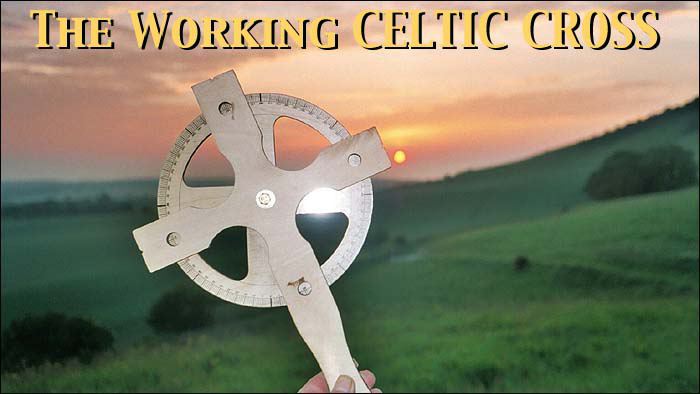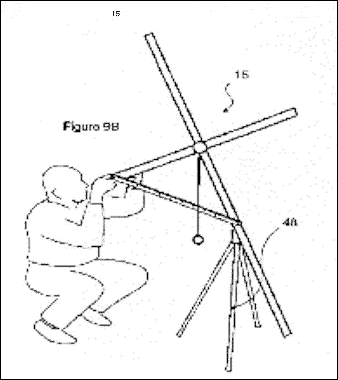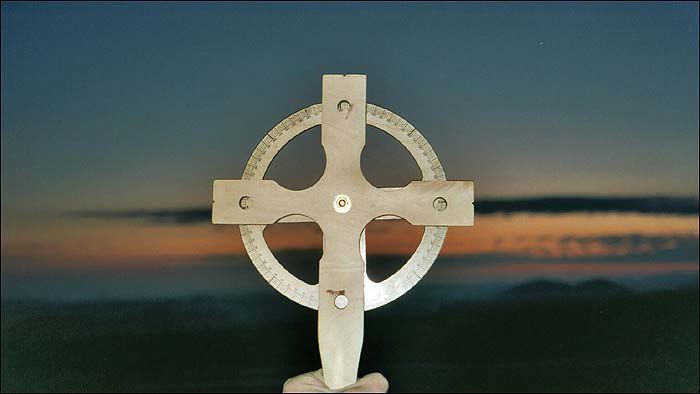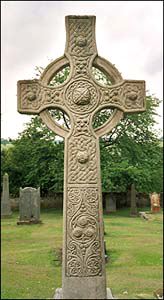 The Working Celtic Cross
By Crichton E M Miller
In 1997 Crichton Miller made an astounding discovery that will change our concepts of the historical and religious past forever. Crichton's background and life experiences play a fundamentally important part in this revelation; he is a qualified yachtsman and navigator with an interest in ancient history and religions. Through the results of intensive research, Crichton proposes that our present system of beliefs and science was inherited from ancient mariners that sailed the oceans of the world in prehistory. He further proposes that the abrupt end of the last ice age, 12,500 years ago, was part of a cataclysm that destroyed of a large part of the flora and fauna of Earth. The most likely humans to survive this cataclysmic event were those who were at sea. Crighton proposes that the event likely produced a tsunami (a large wave that travels extremely fast) and that such a large tsunami would be more easily survived at sea, where the effect would be limited to a large swell on the surface of the ocean. The effects of a large tidal wave on a coastline, however, would be horrendous. The giant wall of water would have been turned into a breaking wave as it reached shallower depths, annihilating all before it as it rushed up the beach with churning debris. Crichton suggests that the sea level around the globe rose with the melting ice caps. Archaeological evidence of earlier civilizations is almost impossible to find since it is now below 300 feet of new sea water which changed the topography of coastlines, where most advanced civilizations were based. However Crichton proposes that there is other evidence of earlier civilizations and that this evidence has been left intact in stone and myth for us to decipher. Crichton believes that these pre-cataclysmic civilizations were maritime based. These ancient sea-going people had developed a form of geometry and mathematics that was linked to astronomy and astrology and developed out of their nautical lifestyles. To successfully travel on the world's oceans and seas, you must be able to know your position and direction. Navigators recognized that the Sun was directly overhead at mid-day. To find the longitude (East and West position) these navigators had to know the approximate time, both locally and at a prime meridian (an arbitrary North-South line from which the plotted position would be calculated). Today the prime meridian is at Greenwich (0 degrees longitude), but Crichton proposes that the original prime meridian was at Giza in Egypt from which all local times and distances were calculated. If this is true, this theory could explain the observed similarities in structures and astronomical orientations in many locations all over the Earth. Crichton proposes that these locations as watch stations. This network of astronomically aligned structures has long been investigated, but in the face of no real evidence, the similarities of these global sites is deemed coincidental. Many investigators and writers have commented on various bits and pieces of evidence that could not be explained. Explorers have brought volumes of information to the public attention. This information has only deepened the sense of mystery and, in some cases, has convinced a large section of the population that aliens must have been involved in these sites. Crichton does not believe that aliens were involved; instead, he prefers to think that we are the aliens because we do not understand the way our ancestors thought and lived. In his book The Golden Thread of Time [ISBN 0-9541639-0-7], Crichton shows that, in comparison to the ancients, we have become very dualistic and have divorced ourselves from nature and the cosmos. Were this not so, we would be able to see what they left behind quite clearly and our civilizations would not be on the brink of disaster through conflict and the destruction of our environment. To prove his point, he has been fortunate in discovering the instrument that the ancients used to measure the stars and the very planet on which we live. The Navigation Instrument This instrument can tell the time, find latitude and longitude, measure the angles of the stars, predict the solstices and equinoxes and measure the precession of the equinoxes. The instrument can also find the ecliptic pole as well as the North and South poles, it can make maps and charts, design pyramids and henges and, when it is used in combination with these observatory sites, can record and predict the cycles of nature. What is this ancient icon that all humanity sees daily and does not recognize? It is the cross. A form of the cross is on all Christian churches and many gravestones; it is in literature and song and can be seen hanging round the necks of the faithful all over the world. The teachers of the Christian faith use it, kneel before it, wear it as part of their raiment and yet they do not recognize it for what it is. The cross is a maritime treasure trove of wisdom and it was likely a vital tool for constructing and designing the pyramids. Crichton has discovered the remnants of a cross hidden by the House of Amen in the Great Pyramid of Khufu at Giza. This amazing cross is capable of measuring angles to an accuracy of three arc minutes. Crichton proposes that the cross is much older than the pyramids since it is also responsible for the construction of Neolithic henges in Europe that predate the pyramids by thousands of years. He has also found that this knowledge was rediscovered and kept secret by the Knight Templars and other "secret societies" throughout the Middle Ages. This great secret probably led to the destruction of the Amerindian civilizations at the hands of the Conquistador when they found them measuring the stars with a form of the cross, called the Staff of Power by the Maya.
You will see that the cross forms an upright with cross bars set at 90 degrees to each other. In the center of the cross is an object that looks like the hub of a wheel. According to Crichton, our ancestors never designed things without purpose and the first purpose of using stone, as a medium, is that of preservation. The second consideration the ancients had was to incorporate and preserve important knowledge for their descendants. In keeping with the concept of not casting pearls before swine, they hid esoteric messages in certain images that they carved so that future seekers could find what he or she was ready to understand. In the present discovery, Crichton proposes that these early stone masons carved a particular object in the ancient cross that closely resembles a wheel and is designed to rotate between cross bars on a hub. If this is the case, as observation seems to confirm, we must then ask why? Crichton observes that in some of the older crosses, early masons incorporated a serpentine design around the wheel and also made the arms of the cross more wide at the outer edge than on the inner. Why? The answer to these questions only came to Crichton when he was experimenting with different methods possibly used by the Egyptians to survey the Great Pyramid and align it with the stars. All constructions require preliminary surveying. The Great Pyramid was an enormous undertaking of civil engineering. Using the simplest of materials and the accepted mathematical techniques of the Egyptian era, Crichton assembled a theodolite, which could carry out the tasks required. With the addition of a scale rule and a plumb line, the instrument resembled cross and was extremely accurate, fulfilling the required task and much more. Not long after his discovery, while carrying out further research, Crichton reviewed the records of the Dixon Relics that were discovered in the North shaft of the pyramid's Queens chamber in 1872. Crichton observed that there were further relics still in the shaft and that these could be seen quite clearly in photographs taken by Rudolph Gantenbrink (1994) with his famous miniature Robot Uphaut 2. Crichton assembled the relics in a logical format and the astounding result was a cross and plumb line of incredible accuracy.
 This artifact is capable of measuring all possible angles. Coupled with sufficient astronomical knowledge, it reveals how the ancients kept time and measured the stars, the position of the Sun, Moon, planets and how they used these measurements to sail the oceans of the world. Crichton has discovered and published this rich source of understanding in his book The Golden Thread of Time [ISBN 0-9541639-0-7]. Many of these revelations have never been seen by the public before and are a must see for those who seek truth and understanding. To further make his point be taken seriously, Crichton Miller applied for a patent on the cross and plumb line and the patent was finally granted in November 2000 as an "astronomical, surveying and navigational instrument" by The British Patent Office. The result of this patent is the instrument you see below. As you can see, it is a faithful representation of the Celtic cross in (Figure 1).
 This resurrected version of the cross is made so that modern people may understand it and compare it with the cross (in figure 1) or with any Celtic cross in any part of the world. The working cross is marked in degrees round the edge and the wheel spins freely on a hub. The cross arms are perforated with viewing holes to allow the observer to read the angles. The bottom of the wheel is weighted so that it will always point to the center of the earth. The scale around the outer edge of the wheel runs from 0 degrees at the bottom to 90 degrees clockwise and anti clockwise, so that horizontal measurements can be taken in any direction through the viewing holes. You can see the advantages of this instrument immediately when you look at the photograph below of an observer measuring the angle of the sun as it rises in the east at dawn. As the world spins round, the sun appears to rise from the horizon and its angle of ascent may be read from the scale directly. This angle changes, as the seasons progress throughout the year, and time and place may be determined from the results of observing stars, planets and constellations.  Crichton considers himself fortunate to have discovered the gift of the cross and to be able to pass this information to his fellow man. According to Crichton, "The cross should be completely understood by as many as possible, for it was the foundation of the very roots of ancient civilization, wisdom and understanding." Crichton believes that, in these current, dangerous and confused times, we could do well seeking some deeper knowledge of what our ancestors knew and begin to enjoy the hope and healing that such knowledge brings. Crichton's website explains much more about his discoveries. His publishers also have a website where a synopsis of his book, The Golden Thread of Time can be read and the book ordered through a secure server.
 |

 To show the comparison of this ancient technology, please look at the photograph of a Celtic cross [pictured on right] in the graveyard of Crichton Churchyard, near Roslyn Chapel in the Scottish borders.
To show the comparison of this ancient technology, please look at the photograph of a Celtic cross [pictured on right] in the graveyard of Crichton Churchyard, near Roslyn Chapel in the Scottish borders.